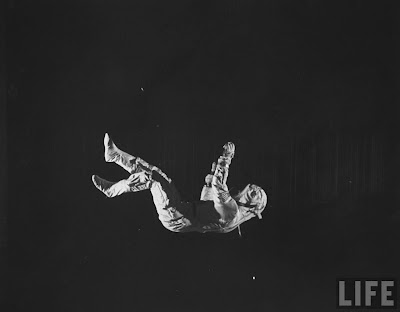Discovery News | Jennifer Ouellette | 2012 Oct 01
Remember when we said that "Doctor Who" fans eager to build their own TARDIS would first need to obtain an odd little item called a trachoid time crystal? The exotic item was first mentioned in a 1976 episode called "The Hand of Fear" as being key to the machine's ability to travel through space and time.
Nobel Prize-winning physicist Frank Wilczek (MIT) suggested such a thing might be mathematically possible, giving hope to aspiring Time Lords everywhere.
Wilczek was teaching a class on 3D crystals: think salt, snowflakes, ice and similar sustances where the atoms or molecules are tightly bound in a very precise lattice-type structure. He started wondering whether you could have a crystal-like structure in the fourth dimension of time -- i.e., a spacetime crystal. He concluded that you could. Theoretically, at least.
Now a team of physicists led by mechanical engineer Xiang Zhang and Tongcang Li think they have come up with an experimental design that would make Wilczek's spacetime crystals a viable reality. Wilczek's paper and the follow-up analysis by Zhang et al. will both be published in Physical Review Letters.
Let's revisit Wilczek's original idea: the atoms in a spacetime crystal would need to rotate constantly and return to their original location, in set periods, like the way planets orbit their stars. As Alexandra Witze explained in Science News back in March:
- To visualize a time crystal, think of Earth looping back to its same location in space every 365¼ days; the planet repeats itself periodically as it moves through time. But a true time crystal is made not of a planet but of an object in its lowest energy state, like an electron stripped of all possible energy.
This object could endlessly loop in time, just as electrons in a superconductor could theoretically flow through space for all eternity.
Nifty though the idea was, Wilczek wasn't sure how to go about building such a thing. He figured the easiest method of getting electrons to behave in such an atypical manner would be to use a superconductive ring.
Zhang and Li thought there might be a better way, using an ion trap to hold charged particles in place. Cool those particles down to just above absolute zero, and they will form a ring-shaped crystal because particles with similar charge naturally repel each other.
Then all you need is to zap those "frozen" ions with a weak magnetic field. This will set the ions rotating in that regular rotating pattern. And they will keep right on rotating, for a very, very long time.
Pretty cool, right? Now it's time for the reality check. First, let us join everyone else in emphasizing that the "space-time crystal" is not -- repeat, NOT -- a perpetual motion machine that defies the laws of thermodynamics.
The standard explanation being bandied about is that this is because it's already in its lowest energy state; hence, no work can be extracted from the system.
The other aspect that has at least one physics blogger feeling a bit dyspeptic is the emphasis in the press release on using such a spacetime crystal to create the perfect clock that could outlast -- wait for it -- the heat death of the universe. You know how the universe will keep expanding, faster and faster, until even black holes evaporate and there's nothing left but a few bits of residual radiation in a vast, cold, dark empty universe? Yeah. The claim is that a clock made with a spacetime crystal would still be ticking even then.
Tom Swanson over at Swans on Tea calls this sort of ploy "writing press release checks your physics can't cash." It's a device, after all, and a macroscopic one at that, requiring an ion trap and the application of electric and magnetic fields -- a drawback that Li acknowledged to New Scientist: "You need to figure out a method to make a laboratory that can survive in the heat death of the universe."
Swanson has a point. An atom or molecule might make it, but a lab? That's a tall order. I mean, you might as well just say you can use the spacetime crystal to build your own TARDIS. (*cough*)
Oh, and in order for such a clock to keep time, one needs to be able to measure the periodic oscillations by shining a laser onto a particular ion, and that's going to mess with the accuracy big-time. "It would be like counting a wheel's rotation by painting a spot on its rim and counting how many rotations you have," Swanson grumbles.
And remember that there's always going to be uncertainty associated with an ion's location because HEISENBERG. As Swanson says, "Go ahead and blame me for being the reason we can’t have nice things that are perfect and last beyond the heat death of the universe."
Computer that could outlive the universe a step closer
New Scientist | Jacob Aron | 2012 Sept 25
A Clock that Will Last Forever
Lawrence Berkeley National Laboratory | 2012 Sept 24
A Space-Time Crystal to Outlive the Universe
Universe Today | Jenny Winder | 2012 July 20
How to Build A Space-Time Crystal
Technology Review | Physics arXiv Blog | 2012 June 26
Crystals may be possible in time as well as space
Science News | Alexandra Witze | 2012 Mar 24
Space-time crystals of trapped ions - Tongcang Li et al
- arXiv.org > quant-ph > arXiv:1206.4772 > 21 Jun 2012
- arXiv.org > quant-ph > arXiv:1202.2539 > 12 Feb 2012 (v1), 11 Jul 2012 (v2)
- arXiv.org > cond-mat > arXiv:1202.2537 > 12 Feb 2012 (v1), 12 Jul 2012 (v2)
